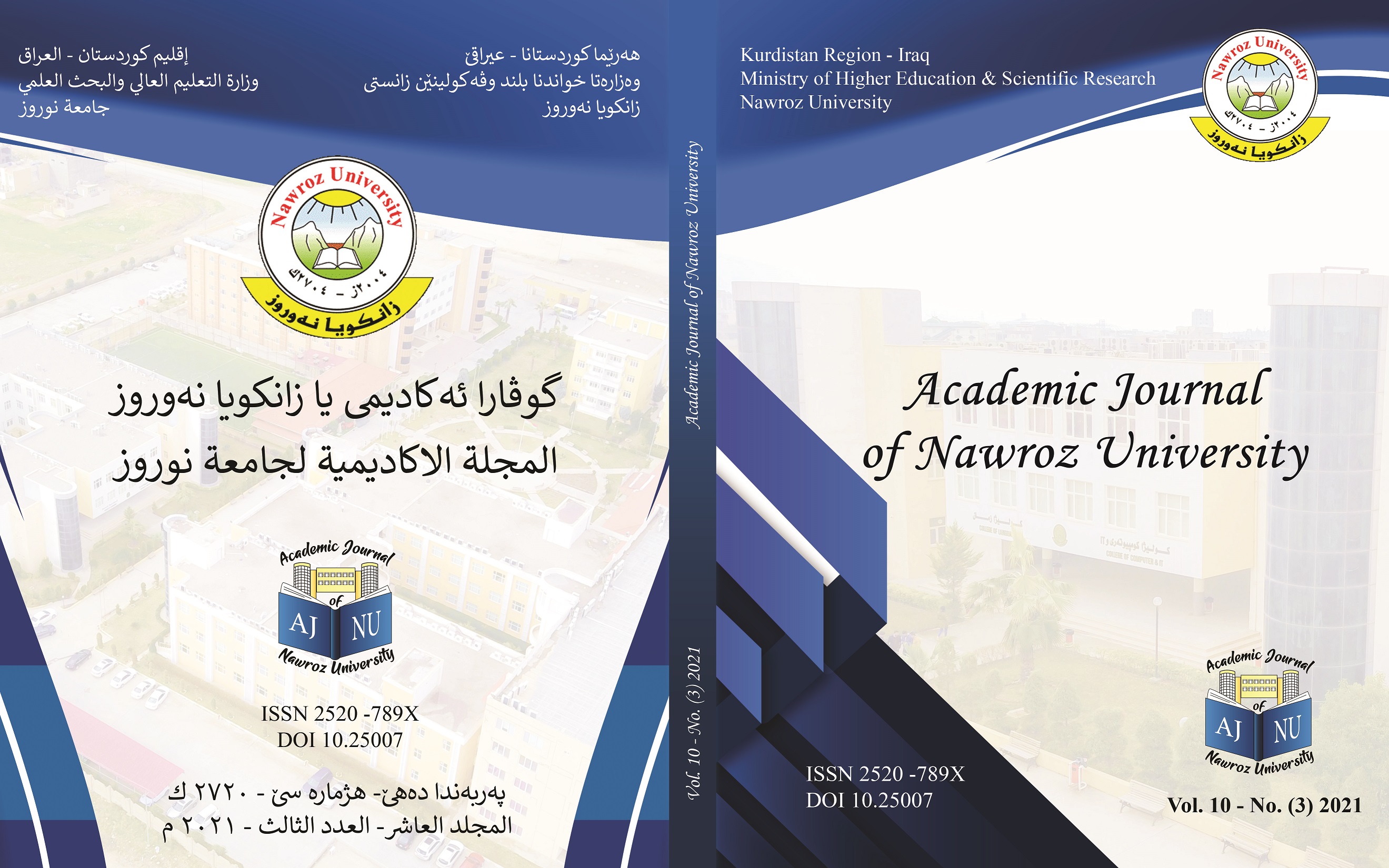Analysis of the impact of the interaction of teachers and students on the continuity of distance education in light of the Corona pandemic / Nawroz University as a model
DOI:
https://doi.org/10.25007/ajnu.v10n3a1119Abstract
In light of growing fears of the spread of covid-19 virus and the closure of educational institutions in all countries of the world, the need for a flexible educational system has emerged, especially as the world faces a future that cannot be predicted, Higher education institutions have therefore begun to move towards distance education as an alternative to attendance education in an effort to maintain the educational process.
Downloads
References
المصادر العربية:
1- الشرهان، صلاح عايد، (2014)، التعليم المفتوح والتعليم عن بعد في الوطن العربي: نحو التطوير والابداع، جامعة الخليج للعلوم والتكنولوجيا، الكويت.
2- منظمة الامم المتحدة للتربية والتعليم والثقافة، مركز الملك سلمان للاغاثة والاعمال الانسانية، (2020)، التعليم عن بعد مفهومه وادواته واستراتيجياته: دليل لصانعي السياسات في التعليم الاكاديمي والمهني والتقني.
المصادر الاجنبية:
1- Arkorful & Abaidoo, The role of e-learning, the advantages and disadvantages of its adoption in Higher Education, International Journal of Education and Research, Vol. 2 No. 12 2014
2- Berrocoso & etal., (2020), Trends in Educational Research about e-Learning: A Systematic Literature Review (2009–2018), Sustainability, vol. 12.
3- Coman & et al., (2020), Online Teaching and Learning in Higher Education during the Coronavirus Pandemic: Students’ Perspective, sustainability, vol. 20.
4- Gilbert, Brittany, (2015), Online Learning Revealing the Benefits and Challenges, master thesis, School of Education
5- Gozalez &etal. , (2019), THE LEARNING PLATFORM IN DISTANCE HIGHER EDUCATION: STUDENT’S PERCEPTIONS, Turkish Online Journal of Distance Education-TOJDE January 2019 ISSN 1302-6488 Volume: 20 Number: 1 Article 5.
6- Kanwar, A.,(2020), Guidelines on Distance Education during COVID-19, Commonwealth of Learning.
7- Sadeghi, M., (2019), A shift from classroom to distance learning: advantages and limitations, International Journal of Research in English Education, no. 4, Vol. 1.
Downloads
Published
How to Cite
Issue
Section
License
Copyright (c) 2021 Eman M. Hasan

This work is licensed under a Creative Commons Attribution-NonCommercial-NoDerivatives 4.0 International License.
Authors retain copyright
The use of a Creative Commons License enables authors/editors to retain copyright to their work. Publications can be reused and redistributed as long as the original author is correctly attributed.
- Copyright
- The researcher(s), whether a single or joint research paper, must sell and transfer to the publisher (the Academic Journal of Nawroz University) through all the duration of the publication which starts from the date of entering this Agreement into force, the exclusive rights of the research paper/article. These rights include the translation, reuse of papers/articles, transmit or distribute, or use the material or parts(s) contained therein to be published in scientific, academic, technical, professional journals or any other periodicals including any other works derived from them, all over the world, in English and Arabic, whether in print or in electronic edition of such journals and periodicals in all types of media or formats now or that may exist in the future. Rights also include giving license (or granting permission) to a third party to use the materials and any other works derived from them and publish them in such journals and periodicals all over the world. Transfer right under this Agreement includes the right to modify such materials to be used with computer systems and software, or to reproduce or publish it in e-formats and also to incorporate them into retrieval systems.
- Reproduction, reference, transmission, distribution or any other use of the content, or any parts of the subjects included in that content in any manner permitted by this Agreement, must be accompanied by mentioning the source which is (the Academic Journal of Nawroz University) and the publisher in addition to the title of the article, the name of the author (or co-authors), journal’s name, volume or issue, publisher's copyright, and publication year.
- The Academic Journal of Nawroz University reserves all rights to publish research papers/articles issued under a “Creative Commons License (CC BY-NC-ND 4.0) which permits unrestricted use, distribution, and reproduction of the paper/article by any means, provided that the original work is correctly cited.
- Reservation of Rights
The researcher(s) preserves all intellectual property rights (except for the one transferred to the publisher under this Agreement).
- Researcher’s guarantee
The researcher(s) hereby guarantees that the content of the paper/article is original. It has been submitted only to the Academic Journal of Nawroz University and has not been previously published by any other party.
In the event that the paper/article is written jointly with other researchers, the researcher guarantees that he/she has informed the other co-authors about the terms of this agreement, as well as obtaining their signature or written permission to sign on their behalf.
The author further guarantees:
- The research paper/article does not contain any defamatory statements or illegal comments.
- The research paper/article does not violate other's rights (including but not limited to copyright, patent, and trademark rights).
This research paper/article does not contain any facts or instructions that could cause damages or harm to others, and publishing it does not lead to disclosure of any confidential information.





